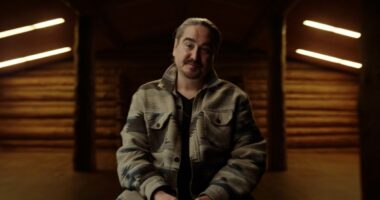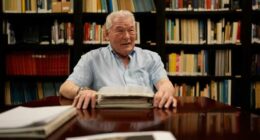Share this @internewscast.com
Dr. Allen Rohe awoke one morning to the unsettling sensation of a “freight train” thundering through his head.
As an audiologist with extensive experience in treating tinnitus—a persistent buzzing or ringing in the ears—Rohe found himself facing the very condition he had spent years helping others manage.
Rohe, a father of two, had been suffering from recurrent sinus infections ever since relocating to Arizona over six years prior, which led to frequent antibiotic prescriptions.
While the antibiotics effectively treated his infections, Rohe discovered one morning in October 2008 that they had also adversely affected his hearing. In rare instances, certain antibiotics can infiltrate ear fluids and produce harmful molecules, resulting in damage that prompts the brain to generate the characteristic tinnitus sounds.
“I had managed hundreds of tinnitus cases before,” Rohe recounted to the Daily Mail, “but now I was living through it myself.”
Rohe endured years of frustration, trying various conventional treatments with little success. Ultimately, he began collaborating with psychiatrists and psychologists to develop a novel, mind-centered approach to tinnitus treatment.
Within months of applying the method to himself, the physician said his symptoms – which had initially been so bad that he could not hear the TV – eased substantially.
After several years, his tinnitus has now virtually disappeared.

Pictured: Dr Allen Rohe, who developed a novel method for treating tinnitus
More than 50million people in the US are estimated to be suffering from tinnitus, equivalent to more than one in ten individuals nationwide. Some US clinics report online that cases are rising. In Denmark, between 2012 and 2021, tinnitus incidence rose by 33 percent, although the cause was not clear.
While the main symptom is a ringing in the ears, doctors say that the vast majority of cases are not caused by an actual sound in the ears, but a phantom perception of a sound generated by the brain in response to a stimulus or stressor.
When the condition is linked to an actual sound, it may be from sigmoid sinus diverticulum, suffered by one percent of the population. It is a condition in which a pouch from a major blood vessel that drains blood from the brain forms in the ear canal, causing someone to hear a near-constant whooshing noise.
Rohe said scans of his ear the day his symptoms began confirmed that he was not hearing the sound literally, but rather it was a pain response from the damage to his ear cells.
In the early months of his condition, Rohe would spend all day talking about tinnitus with his patients, which he found would only make his own condition worse.
By the end of the day, he said the ringing was so bad that he was unable to hear his wife speak to him – or virtually any other noise.
Initially, he tried to manage the condition using tinnitus retraining therapy (TRT), a treatment that attempts to train patients to ‘filter out’ the sound of tinnitus, typically by exposing them to other sounds.
He set up several sound machines in his office that consistently played white noise, which he described as similar to the sound of rainfall, and, while at home, he wore headphones playing the same sound to avoid disturbing his family.
For a time, the devices did work, but they also left him struggling to take part in day-to-day life with his family.
‘I started to really question the wisdom of sound therapy in my life,’ he told the Daily Mail. ‘For me, it was the crickets in the middle of February that didn’t seem realistic or logical.’

Rohe is pictured above treating a patient
It was then, after his tinnitus began to regularly cause him to wake up for hours at a time every night between midnight and 2am, that he started to search for an alternative treatment.
He was aware of cognitive behavioral therapy (CBT) for tinnitus, an alternative treatment where people learn to find and change negative thoughts around the sound and develop coping mechanisms.
But he also knew it still encouraged patients to use sound therapy, such as white-noise machines. He said it was known for having a high drop-out rate, and that it was hard to get on a course as only a few doctors were trained in the therapy.
Seeking a solution that did not rely on sound therapy, Rohe enrolled at the Beck Institute in Philadelphia in 2014, six years after his symptoms began, to formally study CBT.
It was there that, working with psychologists and psychiatrists, he began to develop his own version of the therapy, removing sound-based components altogether.
After several months, he arrived at a new formula.
It was similar to CBT in its focus on encouraging patients to change negative thoughts and direct attention away from their tinnitus, but it also rejected the use of background noise or masking devices.
‘Most patients are probably like me,’ he told the Daily Mail. ‘I said, “If my tinnitus is going to jump another level, I am going to lose my mind.” That is a thought process, and my nervous system responds in spades to what I think.

Symptoms of tinnitus can include a whooshing sound of the heartbeat, a pulse in the ears, a high-pitched ringing noise and the bizarre sound of the eyeballs moving side to side or up and down. (Stock image)
‘So, I had to deep dive into my behaviors to understand what I am doing every time that is making my tinnitus worse.’
He developed an eight-module course – dubbed the Rohe Method – to be administered at his clinic or over the internet, training patients to gradually ‘rewire’ their brains. It costs about $3,200 in total, and generally is not covered by health insurance.
Incorporating elements of audiology, neuroscience, TRT and more, the course is meant to help ‘decouple the emotion from the sound,’ according to Rohe’s website. This allows patients to take control of their reaction to the noise, effectively removing its power to ‘get a rise out of you.’
He told the Daily Mail that his method is not a cure. Still, he said, ‘easily’ over 90 percent of patients that use it get to a place with their tinnitus where they do not need a doctor anymore to help them manage the condition, even years after ending treatment.
Rohe has now treated thousands of patients with his method from all over the world.
He told the Daily Mail that, just before our interview, he had been on a consultation with a woman from New York City who had spoken to six other doctors, but after her symptoms did not improve, she had finally been referred to him.
Rohe is now working on adding foodways to his method, saying that some diets can cause inflammation in the body, that may then lead to the ringing sound in the ears.
When it comes to his own treatment, Rohe said he still maintains the same practices as a sort of upkeep.
‘I still apply my method on a daily basis, just to keep the structure [that staves off] the noise… in tact.’
















